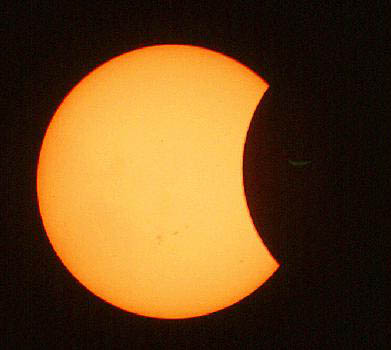UK AND POLISH TEAM TO OBSERVE THE SUN’S ATMOSPHERE FROM LIBYA DURING 29 MARCH 2006 ECLIPSE

A partial eclipse of the Sun. Image courtesy of NASA
A team of three scientists and engineers from the Mullard Space Science Laboratory, UK, and the Astronomical Institute of the University of Wroclaw, Poland, are travelling to Libya to observe the total eclipse of the Sun on March 29th 2006. They will be using an instrument designed to understand why the Sun’s outer atmosphere is so hot.
The solar atmosphere or corona, which is normally only visible from the Earth at times of total solar eclipses, has a temperature of 1—2 million degrees Celsius. The corona also emits ultraviolet and X-ray radiation, which has been observed with spacecraft such as the ESA/NASA Solar and Heliospheric Observatory (SOHO). But despite more than 60 years of study, the heating mechanism of the corona remains unknown.
The instrument used by the Anglo-Polish team, the Solar Eclipse Coronal Imaging System (SECIS), consists of a double telescope on a driven mount with fast-frame electronic cameras that will form images of the corona during eclipse totality at the rate of 40 frames per second. This is far higher than can be accomplished with spacecraft instrumentation because of telemetry restrictions.
The aim is to search for subtle oscillations in the corona’s light intensity - tell-tale signs of heating by magnetic waves, thought by many to be the main heating mechanism on local scales. The oscillations are likely to have periods of a few seconds or less.
Previous observations with SECIS have been successfully made during the total solar eclipses in 1999 (Bulgaria) and 2001 (Zambia), with 12,000 and 16,000 images of the solar corona captured during the few-minute period of totality in each case. Analysis of the 1999 eclipse data suggests an intriguing possibility of a wave travelling along part of the corona.
The present expedition to Libya by the Anglo-Polish team with SECIS will obtain about 10,000 images in the slightly more than 4 minutes of totality. The solar corona should be a little dimmer than in 1999 and 2001, and have a different form as the Sun is now at sunspot minimum – the brightness and shape alter with the 11-year sunspot cycle.
The Anglo-Polish team are going out at the kind invitation of The Planetary Society (Mr Andy Lound, UK Coordinator) and The British Council (Libya), and they are forming a part of the Operation Eratosthenes 2 Expedition which involves a lecture tour in Libya. The observing site is at Jalu, an oasis about 350 km south of Benghazi. The team consists of Dr Pawel Rudawy, Dr Ken Phillips, and Dr Adam Buczylko.
CONTACTS
Dr Ken Phillips
Mullard Space Science Laboratory, University College London, U.K.
E-mail: kennethjhphillips@yahoo.com
Dr Pawel Rudawy
Astronomical Institute, University of Wroclaw University, Wroclaw, Poland
Mobile: 00 48 (0)889 107267
Dr Lucie Green
Mullard Space Science Laboratory, University College London, U.K.
Tel: +44 (0)1483 204103
E-mail: lmg@mssl.ucl.ac.uk
IMAGES
For images of the solar corona during the 1999 eclipse taken using the SECIS instrument and the SOHOspacecraft, see:
http://www.mssl.ucl.ac.uk/~lmg/Press_releases/
TECHNICAL DETAILS
SECIS uses a pair of cameras with charged coupled devices (CCDs) that can image at a rate of 70 frames a second using a specialized computer with dual processors. The data are written to a buffer and transferred to four SCSI disk drives simultaneously. The disk drive capacity is 9GB per disk. The cameras and computer system were made in the U.K.
The corona will be observed with a pair of 15cm aperture reflecting telescopes of Newtonian design, with the cameras directly at the focus of each. The telescopes are on a driven mount, adjustable for any location in the world. The mount was made and the whole system assembled at the Astronomical Institute, Wroclaw, Poland.
Tests were made with the equipment on the full moon in February 2006, and again on the uneclipsed Sun with mylar filters a few weeks later, both in Wroclaw. Exposure times and frame rates were decided on at that stage.
Analysis of the data will be made jointly by Dr Phillips and Dr Rudawy and colleagues, and results will be published in the open scientific literature.
Back to the MSSL News page
![]() +44 (0)1483 204100 - Copyright © 1999-2005 UCL
+44 (0)1483 204100 - Copyright © 1999-2005 UCL